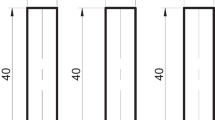Abstract
The hazard caused by the fragments of damaged structures is usually significant in accidental explosions or hostile blast events. A reliable and efficient method to estimate probable fragment size, velocity and launch distance will be useful to assess and design countermeasures to mitigate the possible fragment hazards. This paper presents a numerical method for predicting the size and launch distance of the fragments caused by explosive damage of masonry wall. Numerical simulations with different scaled distances are carried out, and the statistical distribution functions of the fragment size and launch distance in terms of the scaled distance are derived.
Similar content being viewed by others
References
Grady D E. Local inertial effects in dynamic fragmentation [J]. Journal of Applied Physics, 1982, 53(1): 322–325.
Liu L D, Katsabanis P D. Development of a continuum damage model for blasting analysis [J]. International Journal of Rock Mechanics and Mining Science and Geomechanics Abstracts, 1997, 34(2): 217–231.
Zhang Y Q, Hao H, Lu Y. Anisotropic dynamic damage and fragmentation of rock materials under explosive loading [J]. International Journal of Engineering Science, 2003, 41: 917–929.
Shockey D A, Curran D R, Seaman L et al. Fragmentation of rock under dynamic loads [J]. International Journal of Rock Mechanics and Mining Sciences and Geomechanics Abstracts, 1974, 11: 303–317.
Grosten G A, Forsen R, Berglund R. Debris launch velocity from overloaded concrete cubicles [C]. In Proceedings of International Symposium on Interaction of the Effects of Munitions with Structures(ISIEMS). Orlando, Florida, USA, 2007.
Camacho G T, Ortiz M. Computational modeling of impact damage in brittle materials [J]. International Journal of Solids and Structures, 1996, 33: 2899–2938.
Kun F, Herrmann H J. A study of fragmentation process using a discrete element method [J]. Computer Methods in Applied Mechanics and Engineering, 1996, 138: 3–18.
Rabczuk T, Eibl J. Simulation of high velocity concrete fragmentation using SPH/MLSPH [J]. International Journal for Numerical Methods in Engineering, 2003, 56:1421–1444.
Wei X Y, Hao H. Numerical derivation of homogenize dynamic masonry material properties with strain rate effects [J]. International Journal of Impact Engineering 2008 (Accepted).
Wang M, Hao H, Ding Y et al. Prediction of fragment size of masonry wall under blast load using homogenized material model [C]. In: Proceedings of Inaugural International Conference of the Engineering Mechanics Institute (EM08). Minneapolis, Minnesota, USA, 2008.
Kanninen M F, Popelar C H. Advanced Fracture Mechanics [M]. Oxford University Press, New York, 1985
Technical Manual(TM5-1300). Structures to Resist the Effects of Accidental Explosions [M]. Department of the Army, Navy and Airforce, Washington DC, USA, 1990.
Author information
Authors and Affiliations
Corresponding author
Additional information
Supported by the Australian Research Council (ARC, No. DP0774061) and National Natural Science Foundation of China (No. 50638030 and 50528808).
WANG Ming, born in 1983, male, doctorate student.
Rights and permissions
About this article
Cite this article
Wang, M., Hao, H., Ding, Y. et al. Numerical prediction of statistical masonry wall fragment distribution induced by blast loading. Trans. Tianjin Univ. 14, 409–413 (2008). https://doi.org/10.1007/s12209-008-0070-2
Accepted:
Published:
Issue Date:
DOI: https://doi.org/10.1007/s12209-008-0070-2




